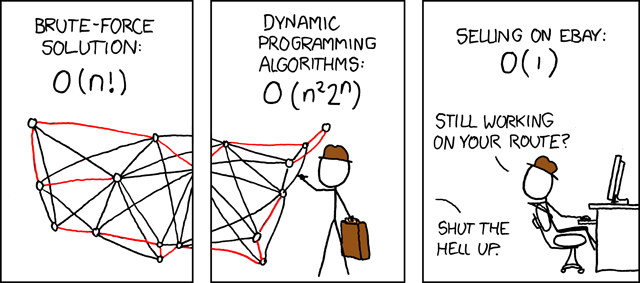Dynamic Programming
Friday, July 13, 20183 mins read
Those who cannot remember the past are condemned to repeat it. — George Santayana
The Fibonacci sequence is defined as follows:
\[F_1 = F_2 = 1\] \[F_n = F_{n−1} + F_{n−2}\]Let’s write a program to find the nth Fibonacci number.
def fib(n):
if n ≤ 2:
return f = 1
else:
return f = fib(n − 1) + fib(n − 2)Notice, some of the numbers are repeatedly evaluated thus this algorithm takes a large amount of running time (exponential). Let’s store the numbers in a dictionary after calculation then we’ll look up the number in the dictionary before evaluation to save time.
memo = {}
def fib(n):
if n in memo:
return memo[n]
else:
if n <= 2 :
f = 1
else:
f = fib(n -1) + fib(n - 2)
memo[n] = f
return fThe above technique of using a look-up table is called memoization. This process of using a memoization based algorithm is dynamic programming. The running time of dynamic programming is given by
\[time = \text{number of subproblems} * time / \text{subproblem} = n * \theta(1) = \theta(n)\]In fact, here we used a top-down approach by solving the subproblems we encountered while solving the problem, there also exists a bottom-up approach of dynamic programming where we first solve all the subproblems before arriving at the problem itself.
def fib(n):
fib = {}
for k in range(1, n):
if k <= 2:
f = 1
else:
f = fib[k - 1] + fib[k - 2]
fib[k] = f
return fib[n]A problem must possess the following characteristics in order to be solvable by dynamic programming:
- Optimal substructure: A problem exhibits optimal substructure if an optimal solution to the problem contains within it optimal solutions to subproblems.
- Overlapping subproblems: When the solution of some of the subproblems are same i.e. subproblems share their solutions, they are said to be overlapping. That is, a recursive algorithm for the problem solves the same subproblem repeatedly.
Writes down “1+1+1+1+1+1+1+1 =” on a sheet of paper.
“What’s that equal to?”
Counting “Eight!”
Writes down another “1+” on the left.
“What about that?”
“Nine!” “ How’d you know it was nine so fast?”
“You just added one more!”
“So you didn’t need to recount because you remembered there were eight! Dynamic Programming is just a fancy way to say remembering stuff to save time later!” — Quora answer1
Dynamic programming differs from greedy algorithms in one aspect, that is, it first find the optimal solution to subproblems then make the choice while greedy algorithms first make a greedy choice then solve the subproblems.
Algorithms solvable using Dynamic programming paradigm:
- 0-1 Knapsack problem
- Parenthesization (Matrix chain multiplication)
- Longest Common Subsequence

References:
1. Introduction to algorithms / Thomas H. Cormen . . . [et al.].—3rd ed.
2. Dynamic Programmin - Wikipedia
3. How should I explain dynamic programming to a 4-year-old? - Quora ↩